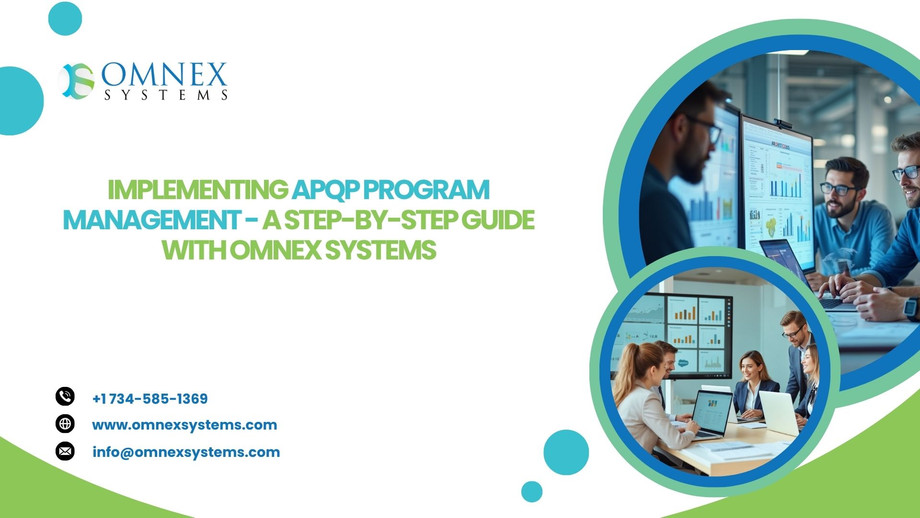
Implementing APQP Program Management - A Step-by-Step Guide with OMNEX SYSTEMS
Implementing a disciplined apqp program management approach is the fastest way to reduce launch risk, improve supplier performance, and hit your production targets. This guide walks you through a practical, step-by-step implementation using OMNEX SYSTEMS as the backbone for APQP, PPAP, linked FMEAs and control plans, and program governance. The steps are written so quality, engineering and program teams can act on them today and see measurable results in weeks not months.
Why apqp program management matters now?
apqp program management brings structure to New Product Introduction work and forces cross-functional alignment on critical inputs like DFMEA, PFMEA, Control Plans, process flows and measurement plans. Modern solutions that combine APQP workflows with BI and document linking reduce duplicate work and speed approvals. OMNEX SYSTEMS positions its APQP/PPAP Manager to centralize those artifacts and to enforce gates and reviews across the NPD lifecycle.
Step 1 - Define scope, success metrics and governance
Decide which product lines, suppliers and programs will be on the initial apqp program management rollout. Define success metrics up front - for example PPAP on-time rate, number of post-launch escapes, average time at each gate, and percent of FMEA actions closed on time. Appoint a program owner, gate reviewers, and a cross-functional steering team. Having clear metrics and governance makes it possible to measure the value after you configure OMNEX SYSTEMS and start a pilot.
Step 2 - Map processes and choose a pilot
Map your existing APQP Program management workflow - from customer requirements and design inputs through PFMEA, Control Plan and PPAP submission - and identify where manual handoffs cause delay. Select a pilot program that is representative yet contained - for example one product family or one supplier chain. A successful pilot reduces resistance and creates internal advocates for the full rollout. Industry best practice encourages pilot-first rollouts to prove the approach and refine templates before scaling.
Step 3 - Configure OMNEX SYSTEMS for your workflow
Use OMNEX SYSTEMS to create project templates that match your APQP phases and your gate criteria. Configure the platform to host DFMEAs, PFMEAs and Control Plans so those artifacts are linked directly to project tasks and gate checklists. OMNEX SYSTEMS supports AIAG-VDA style FMEA and linked electronic workflows so your FMEA, Control Plan and test plan live inside the same project instead of in separate spreadsheets. This reduces version errors and speeds sign off.
Step 4 - Build templates, gate reviews and meetings cadence
Standardize templates for PFMEA, Control Plan, process flow and PPAP submission packets inside the tool. Configure gate review checklists and a Meetings Manager to schedule and capture gate outcomes and action items. With templates and structured gate workflows teams get consistent evidence for approvals and a clear audit trail for customer and regulatory reviews. Making meetings and gate reviews part of the system builds accountability and reduces rework.
Step 5 - Integrate suppliers and PPAP workflows
Onboard suppliers to the tool or provide supplier-facing exports of the exact PPAP package you require. Use the platform to track supplier submissions, nonconformances and corrective action items tied to PFMEA mitigations. Centralizing supplier PPAP evidence and supplier commitments reduces back-and-forth and shortens the time to part approval. Competitor APQP solutions emphasize supply chain integration too, but OMNEX SYSTEMS focuses on linking supplier inputs to project gates so approvals align with your internal NPD milestones.
Step 6 - Train, run the pilot and iterate quickly
Deliver compact hands-on training for the pilot team focused on the templates, meetings flow and how to close FMEA actions. Run the pilot, collect feedback after the first gate and iterate on templates and checklists. Because OMNEX SYSTEMS builds electronic workflows for FMEA and Control Plan linking, your team will close the loop faster on actions and evidence. Capture lessons learned and update the system templates before broader rollout.
Step 7 - Measure, scale and use BI to drive decisions
Once pilot data proves the model, scale up program by program. Use OMNEX SYSTEMS dashboards and business intelligence to monitor KPIs like gate pass rates, overdue actions, supplier submission times and time-to-PPAP. Real-time visibility lets program managers reallocate resources, trigger escalation paths, and publish executive summaries that demonstrate ROI. Integrating BI into apqp program management turns reactive firefighting into proactive risk mitigation.
How OMNEX SYSTEMS compares and where to position your story?
Large PLM and QMS platforms from vendors like Siemens and ETQ also offer APQP modules, PLM integration and enterprise scale capability. Siemens highlights integrated APQP and control plan modules that align quality work with PLM, while ETQ emphasizes APQP apps tied to supplier compliance and QMS workflows. OMNEX SYSTEMS differentiates by focusing on practical APQP program management features such as linked FMEA/control plan workflows, gate review management and meeting-driven approvals that are tuned for NPI teams and tier suppliers. Use competitor features as a reference - then keep your implementation focused on speed, templates and measurable KPIs so users see quick wins.
Final checklist before full rollout
- Confirm templates for DFMEA, PFMEA, Control Plan and PPAP packet are standardized
- Validate gate criteria and Meeting Manager cadence inside OMNEX SYSTEMS
- Ensure suppliers can submit required evidence in the agreed format
- Train gate reviewers on the new approval workflows
- Publish baseline KPIs and target improvements for the first 6 months
Conclusion
apqp program management is not a report or a spreadsheet. It is a repeatable system for aligning people, processes and data across design, manufacturing and suppliers. When you implement a thoughtfully configured platform such as OMNEX SYSTEMS you remove friction, improve traceability and accelerate product launches. Start small with a pilot, measure outcomes with BI, and scale when you demonstrate clear improvements in PPAP on-
For more info Contact Us : +1 734-585-1369 or send mail info@omnexsystems.com to get a quote





